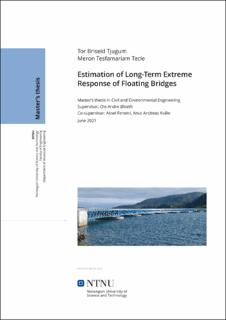| dc.contributor.advisor | Øiseth, Ole Andre | |
| dc.contributor.advisor | Fenerci, Aksel | |
| dc.contributor.advisor | Kvåle, Knut Andreas | |
| dc.contributor.author | Tjugum, Tor Briseid | |
| dc.contributor.author | Tecle, Meron Tesfamariam | |
| dc.date.accessioned | 2021-10-21T18:18:11Z | |
| dc.date.available | 2021-10-21T18:18:11Z | |
| dc.date.issued | 2021 | |
| dc.identifier | no.ntnu:inspera:78584794:15984281 | |
| dc.identifier.uri | https://hdl.handle.net/11250/2824705 | |
| dc.description.abstract | Ved beregning av langtids ekstremrespons for en gitt konstruksjon er som oftest metoden kalt Full Integrasjon anerkjent som den mest nøyaktige. Enkelte utfordringer kan likevel oppstå når komplekse konstruksjoner slik som flytebruer skal undersøkes. Til tross for metodens høye nøyaktighet kan hverken beregningskostnaden eller kjøretiden for denne metoden ignoreres. I denne avhandlingen blir derfor alternative metoder for estimering av langtids ekstremrespons av flytebruer undersøkt og sammenlignet med Full Integrasjon-tilnærmingen. I sammenligningen rettes fokuset både på nøyaktigheten og effektiviteten til disse alternative metodene.
Blant de undersøkte metodene i dette prosjektet er den såkalte Inverse First-Order Reliability Method (IFORM), Environmental Contour Method (ECM) og Monte Carlo Simulering (MCS) med Importance Sampling (IP). I tillegg undersøkes potensialet til Gaussian Process Regression (GPR) for bruk i forbindelse med langtids responsanalyse. Alle de undersøkte metodene er eksemplifisert ved bruk av en forenklet flytebrumodell. Modellen er basert på parametere fra Bergsøysundbrua, en bru som ligger mellom Aspøya og Bergsøya på nordvestlandet. Modelleringen og analysen av bruas pongtonger er utført i GenieE og HydroD, som begge er programvareløsninger utviklet av Det Norske Veritas (DNV). Den forenklede elementmodellen av bruas bæresystem inkludert pongtongdata fra HydroD er generert og analysert i Abaqus. Derfra hentes de udempede naturlige frekvensene og de massenormaliserte modevektorene. Ved hjelp av WAWI-pakken utviklet ved institutt for konstruksjonsteknikk ved NTNU blir responsspekteret for konstruksjonen beregnet.
Når det gjelder metodene for langtidsanalyse viste både IFORM og ECM høy grad av nøyaktighet med et maksimalt avvik på mindre enn 5.7 % mot den konservative siden, sammenlignet med Full Integrasjon. Dette beskjedne avviket kompenseres dessuten til en viss grad av den høye effektiviteten til disse metodene. Monte Carlo Simulering med Importance Sampling basert på resultatene fra IFORM overestimerte responsen, men viste generelt tilstrekkelig nøyaktighet og effektivitet. | |
| dc.description.abstract | In the estimation of long-term extreme responses of a structure, the method of Full Integration is often recognized as the most accurate approach. However, challenges arise when complex structures such as floating bridges are to be investigated. Despite the accuracy of the method, the computational expense and run-time of this approach cannot be ignored. Therefore, in this thesis alternative methods for estimation of long-term extreme responses for floating bridges are compared to the Full Integration approach. In this comparison, emphasis is laid on both the accuracy and efficiency of these methods.
Among the considered methods in this project are the Inverse First-Order Reliability Method (IFORM), the Environmental Contour Method (ECM) and Monte Carlo Simulation (MCS) with Importance Sampling (IS). Finally, the potential application of Gaussian Process Regression (GPR) in performing long-term structural response analysis is investigated. For demonstration, all these methods are applied in long-term analyses of a simplified floating bridge model. This model resembles the Bergsøysund Bridge, located between Aspøya and Bergsøya in the north-western part of Norway. The modelling and analysis of the waterborne pontoons are carried out in GenieE and HydroD, both being software solutions developed by Det Norske Veritas (DNV). The simplified finite element model of the bridge superstructure including the pontoon data from HydroD is generated and analysed in Abaqus from which the undamped natural frequencies and the mass normalized modal vectors are retrieved. By use of the WAWI-toolbox developed at the Department of Structural Engineering at NTNU the response spectrum of the structure is calculated.
Regarding the methods for long-term analysis, both IFORM and ECM showed quite high accuracy with a maximum deviation of less than 5.7 % towards the conservative side when compared to Full Integration. This modest deviation is also to a certain degree compensated by the high efficiency of these methods. Monte Carlo Simulation with Importance Sampling based on the results obtained from IFORM overestimated the response but showed in general sufficient accuracy as well as efficiency. | |
| dc.language | eng | |
| dc.publisher | NTNU | |
| dc.title | Estimation of Long-Term Extreme Response of Floating Bridges | |
| dc.type | Master thesis | |
